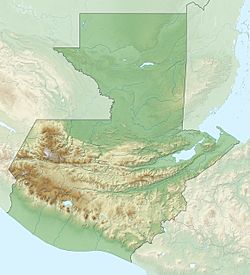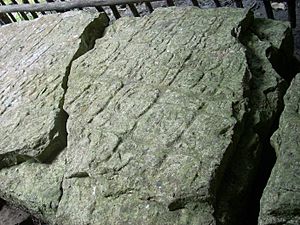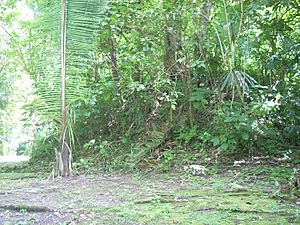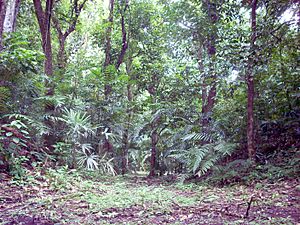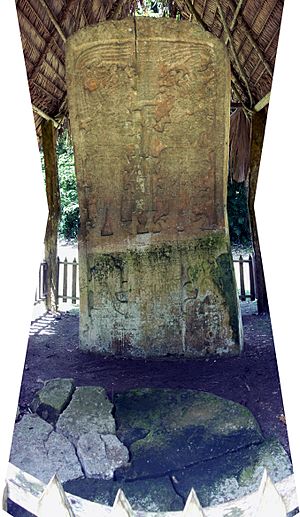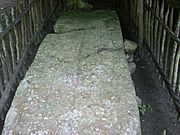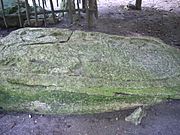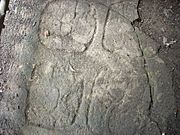Ixkun facts for kids
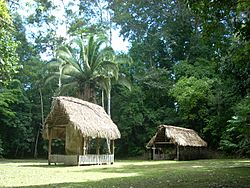
The North Plaza with Stelae 1 and 2
|
|
| Location | Dolores |
|---|---|
| Region | Petén Department, |
| Coordinates | 16°34′25″N 89°24′40″W / 16.57361°N 89.41111°W |
| History | |
| Periods | Late Classic |
| Cultures | Maya civilization |
| Site notes | |
| Archaeologists | Juan Pedro Laporte Atlas Arqueológico de Guatemala |
| Architecture | |
| Architectural styles | Classic Maya |
Ixkun (also spelled Ixcún or Ixkún) is an ancient Maya city. It is an important archaeological site in the southern Maya lowlands. You can find it north of the town of Dolores in Guatemala.
Ixkun was the capital of one of the four biggest kingdoms in its valley. The other kingdoms were Curucuitz, Ixcol, and Ixtonton. Eight smaller sites were part of Ixkun's kingdom. This shows that Ixkun was the most important city. One of its stone monuments, Stela 1, is among the tallest in the whole Petén area.
People lived in Ixkun from the Late Preclassic period until the Postclassic period. However, the city was most active during the Late Classic period.
Contents
Where is Ixkun located?
Ixkun is in the Dolores area, about 6.5 kilometres (4.0 mi) north of Dolores town. It sits on a plateau in the southern part of Guatemala's Petén Department. The city is built on hills within a large valley. The Mopan River flows about 4 kilometres (2.5 mi) east of the ruins.
The kingdom's land included wide areas good for farming. Ixkun was also on a north-south trade route. This route connected the Dolores Valley to the Mopan River. It helped control access to other cities like Ucanal.
Ixkun is about 35 kilometres (22 mi) southwest of the large Maya city of Caracol. It is also 7.5 kilometres (4.7 mi) north of the ruins of Ixtonton.
Who ruled Ixkun?
| Nickname | Ruled |
|---|---|
| Eight Skull | –around 790 AD |
| Rabbit God K | around 790–800 AD |
What is Ixkun's history?
People first settled in Ixkun during the Late Preclassic Period. Early Classic buildings were later built over these older remains. The city was busiest during the Late Classic period. Even though construction slowed down in the Terminal Classic, people still lived there. There is also proof of some people living there in the Postclassic Period.
Ixkun's history seems closely connected to the nearby city of Sacul. The friendships and fights between Ixkun and other cities like Sacul and Ucanal show how Maya politics worked.
Early beginnings
The first settlements in the Ixkun kingdom area were in the Middle Preclassic. Ixkun itself shows signs of early life. People also used nearby caves for special ceremonies.
Growing into a city
In the Early Classic period, more people settled in Ixkun. Archaeologists found some Early Classic pottery near the city's center.
Peak of power: Late Classic
Ixkun grew steadily during the Late Classic Period. The city center got bigger, more homes were built, and stone monuments were put up. During this time, Ixkun became the capital of its kingdom. It controlled a large area with several smaller sites. The kingdom was strongest around the late 700s AD. This is shown by the carved monuments found there.
A king from Caracol, Tum Yohl K'unich, took part in a ritual with Ixkun's king. This event was written on a wall in the Naj Tunich cave.
Ixkun was burned in 779 AD. In the same year, Ixkun fought a war against Sacul and won. On May 10, 780 AD, Ixkun won another battle, this time against Ucanal. Sacul and Ucanal were allies. So, it is thought that Ucanal stepped in to help Sacul after Ixkun defeated them. These wars likely happened when "Eight Skull" was king of Ixkun.
However, the fighting with Sacul did not last. Stone monuments in both cities show that Ch'iyel, the king of Sacul, visited Ixkun on October 11, 790 AD. At this time, King Rabbit God K ruled Ixkun. Ixkun and Sacul then formed a military alliance against another city. That city's name is not clear, but it might have been Ixtonton.
Decline: Terminal Classic
Many people lived in Ixkun during the Terminal Classic Period. Around 800 AD, King "Rabbit God K" put up the last carved monument. He was also getting ready for new building projects. Construction materials were piled up in the city center, but these projects were never finished.
However, people kept living in the city's residential areas. This suggests that the workers were busy elsewhere, not that the city was empty. It is likely that Ixkun became less important than nearby Ixtonton. The smaller population then depended on Ixtonton. Other cities in the Dolores Plateau faced a similar fate.
Later years: Postclassic
Archaeologists found signs of homes being used in the Postclassic period. These were in Group 37 and Group 38, east and west of the North Causeway.
Modern discoveries
People have been exploring Ixkun since the 1800s. This is partly because of the impressive Stela 1. Modesto Méndez, a governor, visited the ruins in 1852. He might have asked Eusebio Lara to draw the monuments. Alfred Maudslay visited Ixkun in 1887. He mapped the ruins and might have found Stelae 2 and 3. He also drew and photographed Stela 1 and made a mold of it. Maudslay's digging at Structure 6 was one of the first formal archaeological studies in the Maya Lowlands.
Sylvanus Morley visited the site in 1914 with Herbert Spinden. They remapped the ruins and recorded some of the writings. They also took photos of the monuments.
Ian Graham visited Ixkun in 1971, 1972, and 1978. He also remapped the site and photographed the monuments. He moved the remaining pieces of the stolen Stela 5 to Dolores for safekeeping. Since 1985, the Altas Arqueológico de Guatemala (Archaeological Atlas of Guatemala) has been studying Ixkun. Oswaldo Gómez explored the two causeways in 1993. Other groups were excavated in 2001 by Claudia Valenzuela, Varinia Matute, and Erika M. Gómez.
What does the site look like?
Ixkun shows signs of being lived in from around 200 AD. It reached its peak between 600 and 900 AD. The site is large, covering about 16 kilometres (9.9 mi). Its main area includes a ballcourt, temples, palaces, and two medium-sized pyramids.
Archaeologists have mapped 51 building groups in the ancient city. Most of these were homes. There are at least 46 residential groups with 245 mounds. There are also several chultuns (underground rooms for water or storage). An important building complex is on a hill south of the city center. Four nearby caves were used for ceremonies during the Classic Period.
The city center was built in three main stages during the Late Classic period.
City center
The city center is built around several open areas called plazas.
The Acropolis was built around several patios. Patio 1 was built around 779 AD. Patio 2 shows unfinished construction from the Terminal Classic. Two buildings were in use when the city was left, but a third building (Structure 18) was just a pile of dirt.
The North Plaza (also called Plaza A) was also used during the first building stage of the Late Classic.
The Central Plaza (also called Plaza B) was first used in the earliest building stage of the Late Classic.
The South Plaza (also called Plaza C) was built during the second stage, around 779 AD.
The E-Group is in the middle of the city. It has six buildings arranged in a typical way for this type of complex. The East Platform holds a temple with several rooms. The West Pyramid has a square base. The E-Group was expanded with north and south platforms around 779 AD.
The Ballcourt is also in the city center. The first version was built around 779 AD. It is aligned north-south.
The South Group (also called Group 3) is on a hill about 200 metres (660 ft) south of the city center. It is connected by a causeway.
Ancient roads: Causeways
The South Causeway runs south from the South Plaza to the South Group. It is 215 metres (705 ft) long and 15 metres (49 ft) wide. It is raised 1.3 metres (4.3 ft) above the ground. It connects the South and Central Plazas with the South Group. At its southern end, there was a platform with monuments like Stela 5. Near the middle, the causeway's wall also held a small water reservoir.
The North Causeway runs north from the North Plaza to Group 50. It is 288 metres (945 ft) long and 14 metres (46 ft) wide. It is raised 1.45 metres (4.8 ft) above the ground. This causeway has well-preserved walls. The eastern wall also helped protect against floods from a nearby stream.
Group 37
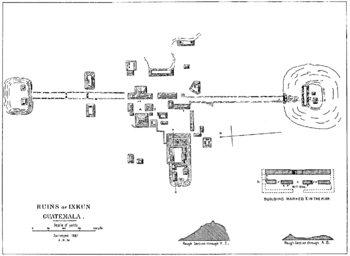
Group 37 is a complex east of the North Causeway. Most of it dates to the Late Classic. Since it was near the causeway, experts think it was used for administration. It might have controlled who entered the city's plazas. In the Terminal Classic, it became a living area.
Structure 37 is the main platform. It measures 37 by 19 metres (121 by 62 ft) and was important. It stands 5.7 metres (19 ft) high and holds three buildings. People reached it by a stairway on the south side. Structure 37 was built in three stages. The earliest stage is from the Early Classic. The later stages are from the Late Classic. People continued to live in Group 37 through the Terminal Classic into the Postclassic Period.
Structure 37-A is the main building on Structure 37. It was the first of the three buildings constructed. It measured 11 by 5.6 metres (36 by 18 ft).
Group 38
Group 38 is a complex west of the North Causeway. It is built on a high platform. Not many pottery pieces were found here. Most activity happened in the Terminal Classic. Some Early Classic pottery was found at the base. People continued to live here in the Postclassic. This group likely served an administrative role, controlling the causeway.
Structure 38 is the base platform. It was built during the Early Classic. It measures 28 metres (92 ft) east-west by 15 metres (49 ft) north-south. It stands 4.3 metres (14 ft) high. People reached it by a stairway on the west side.
Group 50
Group 50 is about 300 metres (980 ft) north of the city center. It is connected by the North Causeway. Group 50 has 4 buildings at the city's far north. The two main buildings are Structures 41 and 43. Very few artifacts were found here, mostly pottery from the Late to Terminal Classic.
Structure 41 is one of the two main buildings. It was not fully explored due to its size.
Structure 43 is the second main building in Group 50. It was also not explored due to its size.
Important buildings
Structure 3 faces the North Plaza.
Stone monuments
Archaeologists have found seven carved monuments at Ixkun. These include both stelae (tall stone slabs) and altars. Five of them talk about events between 766 AD and 800 AD. There are also 11 plain monuments. All the carved monuments share a similar style. Most stelae in this style are carved on only one side. They often show rulers standing and facing left. War captives are sometimes shown below the ruler.
In total, eleven stelae and six altars are known at the site.
Stela 1 was placed in the middle of the North Plaza. It is made of limestone and stands 4.13 metres (13.5 ft) high. It has holes bored into its edges. These might have held torches or banners. It is carved on only one side. It shows King "Rabbit God K" and the visiting King Ch'iyel of Sacul. Their visit happened on October 11, 790 AD. The monument has five carved hieroglyphic panels, but some writings are hard to read. It seems to record a military alliance between the two kings. Stela 1 is the largest known stela in its region and one of the tallest in the entire Petén area. It is special because it shows two important people facing each other. The figures hold symbols of power, and two tied-up war captives are carved below them.
Stela 2 tells about two battles. One was against Sacul on December 21, 779 AD. The other was against Ucanal on May 10, 780 AD. The writing on the stela names "Rabbit God K's" predecessor, "Eight Skull." Stela 2 is in front of Structure 6 in the North Plaza. It is broken into many pieces. When Alfred Maudslay found it, it had already fallen face down and broken.
Stela 3 is near Structure 6 in the North Plaza. It is made of limestone and has fallen face up, so its carved side has worn away. Only the top half remains. It is too worn to read any writing. It shows a ruler facing left, holding a God K scepter.
Stela 4 is in the Central Plaza. It is broken and worn. It is carved from limestone on one side. Like Stela 3, it shows a ruler holding a God K scepter. A war captive is shown below the ruler. Because it looks similar to Stela 1 and is from the same time, it is believed "Rabbit God K" dedicated it. The stela has writing that includes a date of 796 AD. The ruler is shown standing, richly dressed, with a feathered headdress. The prisoner is shown looking up, with long hair and bound arms.
Stela 5 was the last carved monument put up at Ixkun. King "Rabbit God K" raised it around 800 AD. The main figure on the stela holds a staff of power. The ruler wears a fancy feathered headdress shaped like a jaguar or puma head. They are also decorated with jewelry. A war captive is carved below the main figure. Stela 5 was placed on a platform at the end of the South Causeway. It was badly damaged in 1972 by people who stole pieces. Some pieces were moved to Dolores for safety.
Stela 12 was placed in the Central Plaza. It is thought that King "Eight Skull" dedicated it. Stela 12 is carved on one side and is broken into two pieces. It might have been reused in building Structure 10. It was found in 1985. The writing on it is too worn to read clearly.
Altar 1 is found with Stela 1. It is a round monument, 2.05 metres (6.7 ft) across and 0.35 metres (1.1 ft) thick. Looters dug a pit under it, causing Stela 1 to tilt. This damage was fixed in 1988.
Altar 2 is west of Stela 3 in the North Plaza. It was found buried under dirt. It is made of limestone and is broken. It has four carvings on its top surface, but they are too damaged to read. It is believed to be from the late 700s AD.
Altar 3 is found with Stela 5, at the end of the South Causeway.
Burials
Burial 228 was found in a stone box inside Structure 37. The box measured 1.7 by 0.65 metres (5.6 by 2.1 ft). The skeleton was very poorly preserved. It belonged to at least one adult. The person was laid with their head at the west end. A ceramic plate was placed near the skull. A cylindrical ceramic pot was at the east end. This burial and its items are from the Terminal Classic period.
Images for kids
See also
 In Spanish: Ixkún para niños
In Spanish: Ixkún para niños


